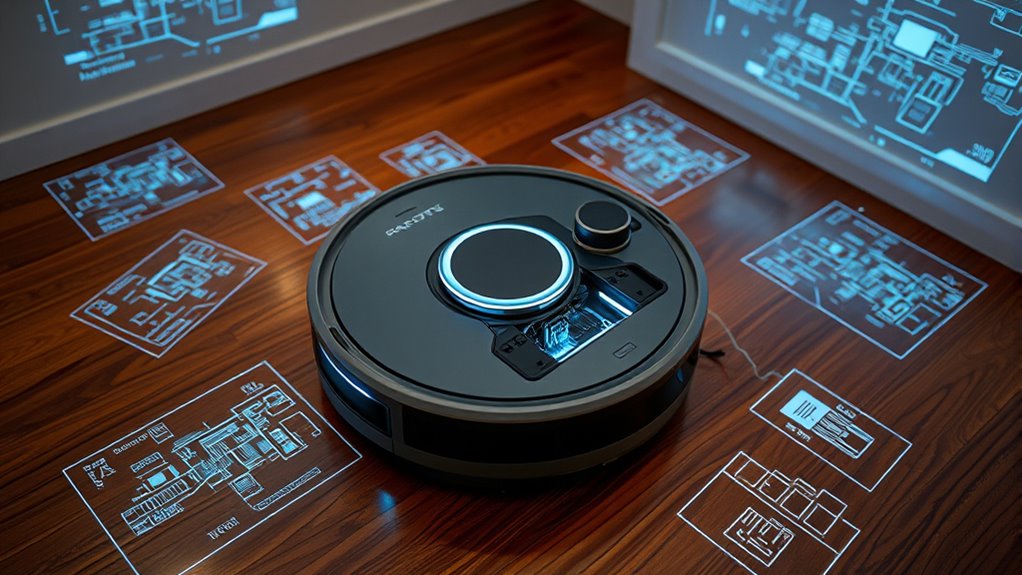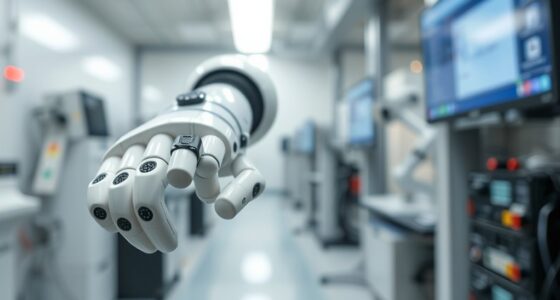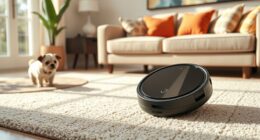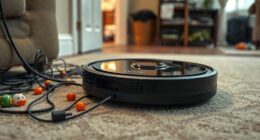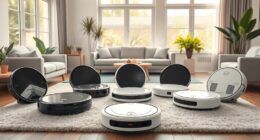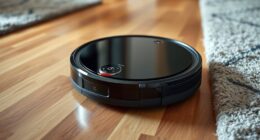Your robot vacuum collects detailed data about your home, including floor plans, obstacle locations, and room sizes, using sensors and cameras. This information helps it navigate and clean efficiently. Your privacy depends on how this data is stored, transmitted, and protected, often through encryption and privacy policies. Staying informed about these practices guarantees your data remains secure. Keep going to discover how to manage your privacy and control what your device knows.
Key Takeaways
- Robot vacuums collect detailed spatial data, including floor plans, room dimensions, and obstacle locations during mapping.
- Data is encrypted during transmission and storage to protect your privacy.
- Users have rights to access, delete, or manage their mapping data through privacy controls.
- Mapping data can be shared with third parties only with user consent, depending on privacy policies.
- Regular device maintenance and privacy settings help ensure your mapping information remains secure.
How Robot Vacuums Map Your Home
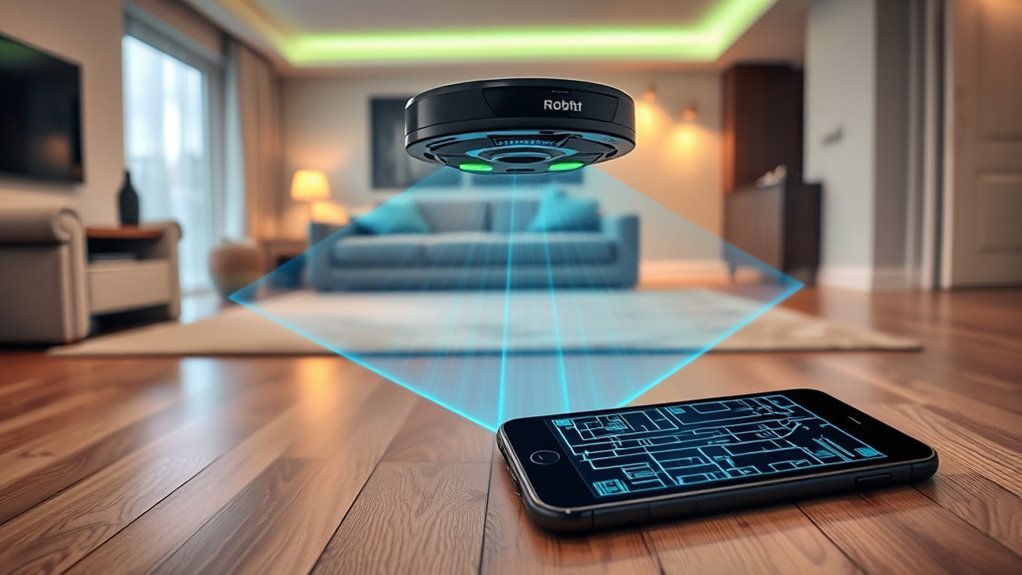
Have you ever wondered how robot vacuums navigate your home? It all comes down to mapping accuracy. Your device uses sensors and cameras to create a digital map of your space, allowing it to clean efficiently. Proper device calibration is essential; if your vacuum isn’t calibrated correctly, its sensors may misjudge distances or miss areas altogether. Regular calibration ensures that the robot’s sensors are aligned, improving the precision of the map. This process helps the vacuum understand obstacles, furniture, and room boundaries. When calibration is off, navigation can become erratic, leading to missed spots or repeated paths. Ultimately, accurate mapping depends on both the quality of the sensors and how well you maintain and calibrate your device. Resources and Tools such as access to high-quality sensors can significantly enhance mapping accuracy, ensuring safe, thorough cleaning every time.
Types of Data Collected During Mapping
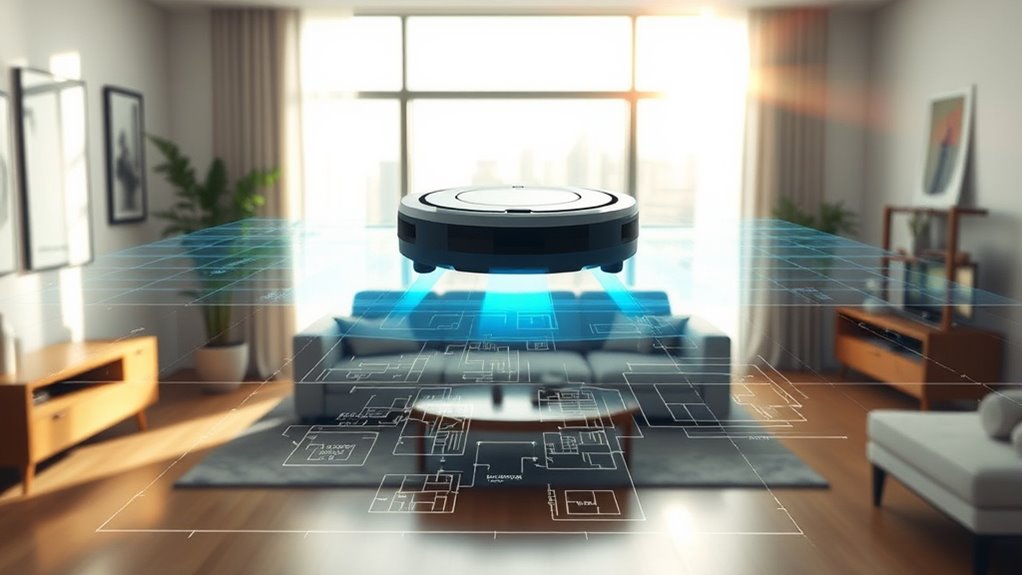
When your robot vacuum maps your home, it gathers various types of data to create an accurate layout. This includes spatial measurements, floor plans, and location points. Some data, like room sizes, can be anonymized through data anonymization techniques, removing personal identifiers. Encryption protocols protect this information during transmission and storage, ensuring unauthorized access is prevented. Here’s a quick overview:
| Data Type | Purpose | Privacy Measures |
|---|---|---|
| Spatial measurements | Map creation | Data anonymization, encryption |
| Floor plans | Accurate navigation | Encryption protocols, anonymization |
| Location points | Movement tracking | Encryption, anonymization |
| Room dimensions | Optimize cleaning paths | Data anonymization, encryption |
Implementing these privacy measures helps safeguard your privacy while your vacuum learns your home.
The Role of Sensors and Cameras in Data Gathering
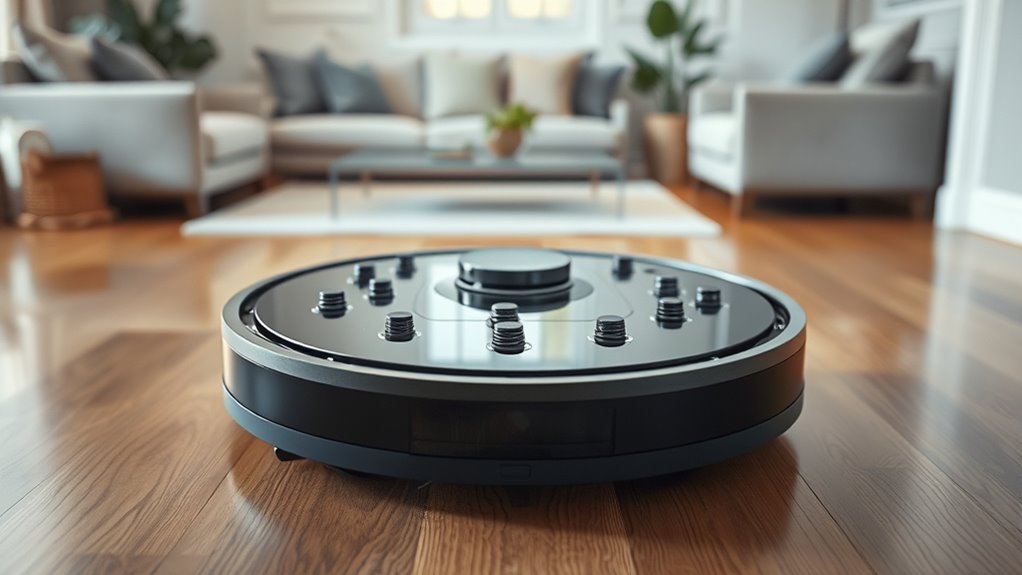
Sensors and cameras are essential tools that enable your robot vacuum to navigate effectively and gather detailed data about your home. They rely on high sensor accuracy and camera resolution to map your space precisely. Accurate sensors detect obstacles and measure distances, while high-resolution cameras capture detailed images of your surroundings. This combination allows your vacuum to create thorough maps, improving cleaning efficiency. To understand their importance, consider these aspects: 1. Sensor precision ensures reliable obstacle detection and navigation. 2. Camera resolution determines the clarity of visual data collected. 3. Both technologies work together to build accurate, real-time maps of your environment. Proper maintenance of sensors is also vital to ensure consistent performance and longevity of your device.
Storage and Transmission of Mapping Data

As your robot vacuum navigates and maps your home, it continuously collects data that needs to be securely stored and efficiently transmitted. Many models use AI integration to optimize cleaning routes and improve performance, but this also means your mapping data must be handled carefully. Manufacturers often employ data anonymization techniques, removing personally identifiable details before storage or transmission, to protect your privacy. This data is typically encrypted both at rest and in transit, ensuring unauthorized parties can’t access sensitive information. Efficient transmission protocols minimize bandwidth use, allowing quick uploads to cloud servers or local devices. By combining AI-driven processing with robust security measures, manufacturers aim to balance the benefits of smart navigation with the need for safeguarding your home’s layout and your privacy. Additionally, understanding Paint Sprayer Reviews & Buying Guides can provide insights into how technology and security considerations are integrated into various devices.
Privacy Policies of Major Robot Vacuum Brands
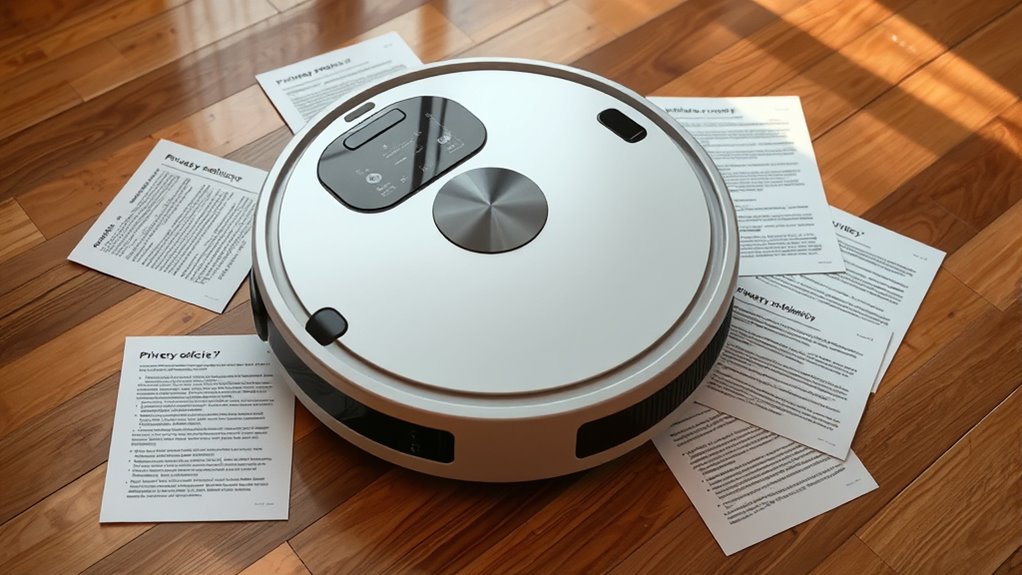
Major robot vacuum brands have established privacy policies to clarify how they handle the data collected during cleaning sessions. These policies emphasize data encryption, ensuring your mapping data remains secure during transmission and storage. They also outline how privacy enforcement is maintained, with strict access controls and regular audits. To understand their approach better, many companies incorporate industry trend insights to stay compliant with evolving privacy standards. They specify data collection limits and user rights. They detail the use of data encryption to protect sensitive information. They describe privacy enforcement measures like access restrictions and compliance checks.
Potential Risks of Data Breaches and Unauthorized Access
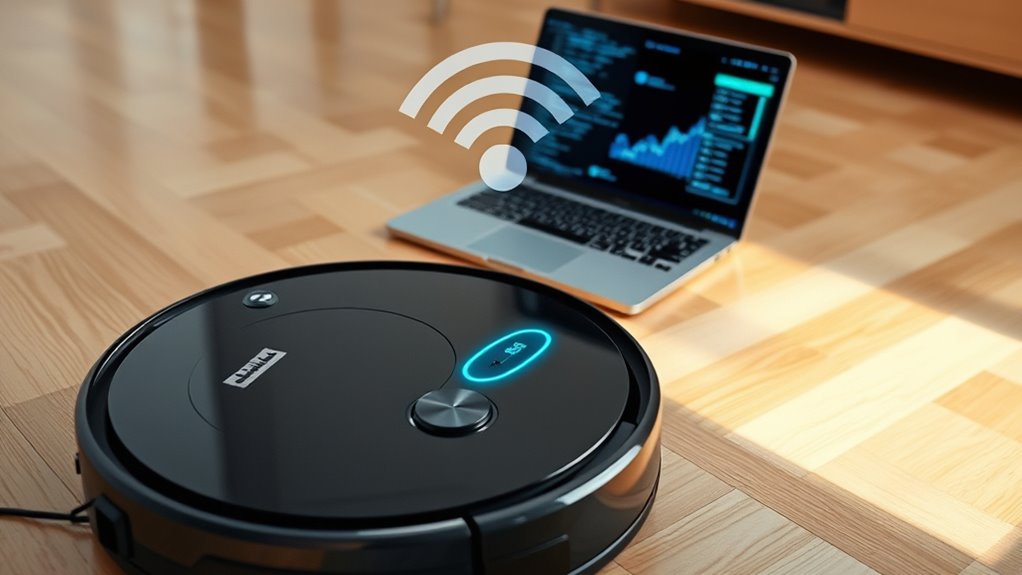
You need to be aware that unauthorized data harvesting can put your personal information at risk. If hackers access your data, it increases the chance of identity theft and financial loss. Gaps in privacy policies can make it easier for your information to be mishandled or misused. Ensuring brand trustworthiness is crucial when considering the security of your data with smart devices.
Unauthorized Data Harvesting
Unauthorized data harvesting occurs when malicious actors exploit vulnerabilities to collect personal information without consent, posing significant risks to individuals and organizations. These breaches can lead to privacy violations, financial loss, and damage to trust. To protect yourself, consider these points:
- Weak data encryption allows hackers to intercept unprotected information.
- Ethical concerns arise when companies collect data without transparent consent.
- Vulnerabilities in device security can enable unauthorized access and data harvesting.
- Ensuring devices are vetted and adhere to Mother Baby Kids safety standards can reduce risks of data breaches.
Identity Theft Risks
How vulnerable is your personal information to theft? If your robot vacuum collects data like your address, routines, or device details, it could become a target for identity theft. Hackers may exploit security gaps to access this sensitive information, potentially forging your identity or draining your accounts. Unauthorized access can lead to significant financial and emotional damage. Even seemingly harmless data can be combined with other breaches to create a clearer picture of your identity. The more personal information your devices store or transmit, the higher your risk. Protecting your data requires awareness of these vulnerabilities and proactive security measures. Remember, your personal information isn’t just stored; it’s a valuable commodity for cybercriminals seeking to commit identity theft. Regularly updating your device security and being aware of glycolic acid formulations can help you stay informed about product safety and security measures.
Privacy Policy Gaps
Have you ever considered how gaps in privacy policies can expose your personal data to risks? These gaps can leave you vulnerable to data breaches and unauthorized access. For example:
- Lack of clear data encryption protocols can make your information easier to intercept.
- Vague policies on third-party sharing may allow your data to be sold or misused without your consent.
- Insufficient transparency about data collection processes can hide potential vulnerabilities.
- Awareness of Forsale 100 can help you understand the importance of secure data handling practices.
When privacy policies fail to specify how data is protected or shared, hackers and malicious actors can exploit these weaknesses. Ensuring robust data encryption and clear restrictions on third-party sharing is essential. Without these safeguards, your personal data remains at risk of being compromised.
Rights and Controls Over Your Mapping Data
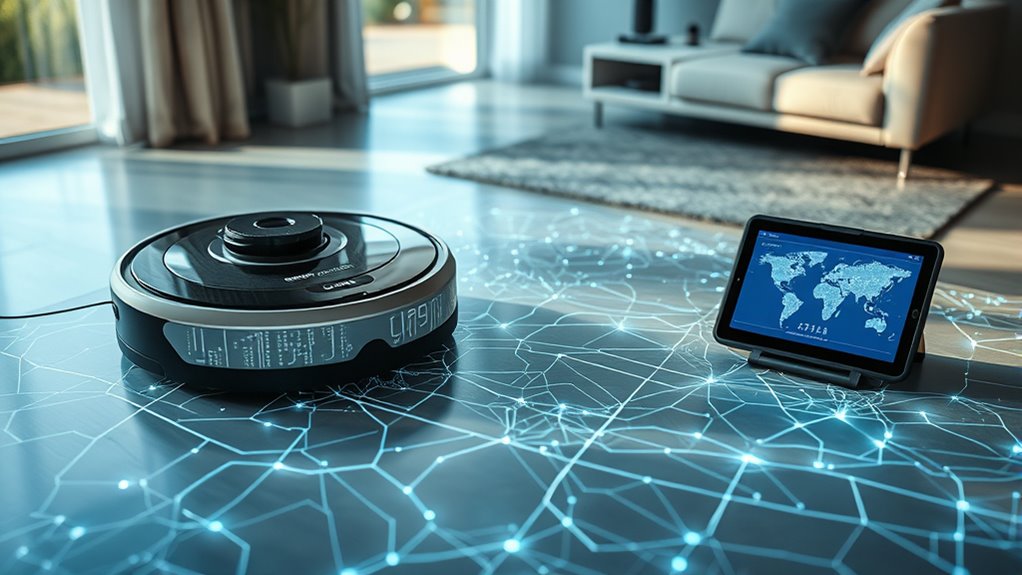
You have the right to control how your mapping data is used, starting with giving clear consent and permissions. You can also request to delete your data or access it anytime you want. Knowing your rights helps you manage your information and protect your privacy effectively. Understanding vibrational alignment can also empower you to influence how your data reflects your intentions and experiences.
User Consent and Permissions
Ever wonder who controls your mapping data once it’s collected? Your user control and consent management are key. Manufacturers often require your permission before gathering detailed maps of your home. They might ask you to opt-in or adjust settings to manage permissions. Here’s what you should consider: 1. How easily can you grant or revoke access to your mapping data? 2. Do you have clear options to customize what information is shared? 3. Are you informed about how your consent impacts data use and privacy? Additionally, understanding the perfect fit living approach can help ensure your privacy needs are fully addressed.
Data Deletion and Access
Understanding your rights to access and delete your mapping data is essential for maintaining control over your privacy. You should be able to review and retrieve your data whenever you want, ensuring transparency with your robot vacuum’s data collection. Data access allows you to see what information is stored and how it’s used. If you no longer want certain data retained, data deletion gives you the power to remove it completely. Many manufacturers provide options within their apps or customer support to manage these rights. Regularly checking your device’s privacy settings helps ensure your preferences are respected. By actively managing data access and deletion, you retain control over your personal information, reducing privacy risks and fostering trust in your smart home devices. Additionally, understanding privacy and cookie usage can help you better comprehend how third-party cookies might impact your data security.
Best Practices for Protecting Your Privacy

Protecting your privacy in today’s digital landscape requires implementing effective strategies that minimize exposure and safeguard personal information. To do this, consider these best practices:
Safeguard your digital privacy with proactive settings, ethical choices, and strong security measures.
- Regularly review and adjust privacy settings on your devices and apps, ensuring you control what data is shared.
- Be aware of the ethical implications and legal considerations involved in data collection, and choose devices that prioritize user privacy.
- Use strong, unique passwords and enable two-factor authentication to protect your accounts from unauthorized access.
- Be attentive to the cookie categories used by devices and websites, and customize your preferences to limit unnecessary data collection.
Future Trends in Privacy and Data Security for Smart Devices

As smart devices become more integrated into daily life, the landscape of privacy and data security is poised for significant advancements. AI integration will play a pivotal role, enabling devices to better detect and respond to security threats in real time. This technology can also help improve user privacy by offering smarter data management and control options. Data anonymization will become more sophisticated, ensuring your personal information remains protected even as devices collect and analyze vast amounts of data. Future trends include enhanced encryption methods and decentralized data storage, reducing the risk of breaches. Organizations increasingly rely on AI security technologies to safeguard sensitive information, further strengthening user trust. As a user, you’ll see smarter, more secure devices that prioritize your privacy without sacrificing functionality. These developments aim to balance innovation with trust, shaping a safer connected future.
Making Informed Choices When Using Robot Vacuums
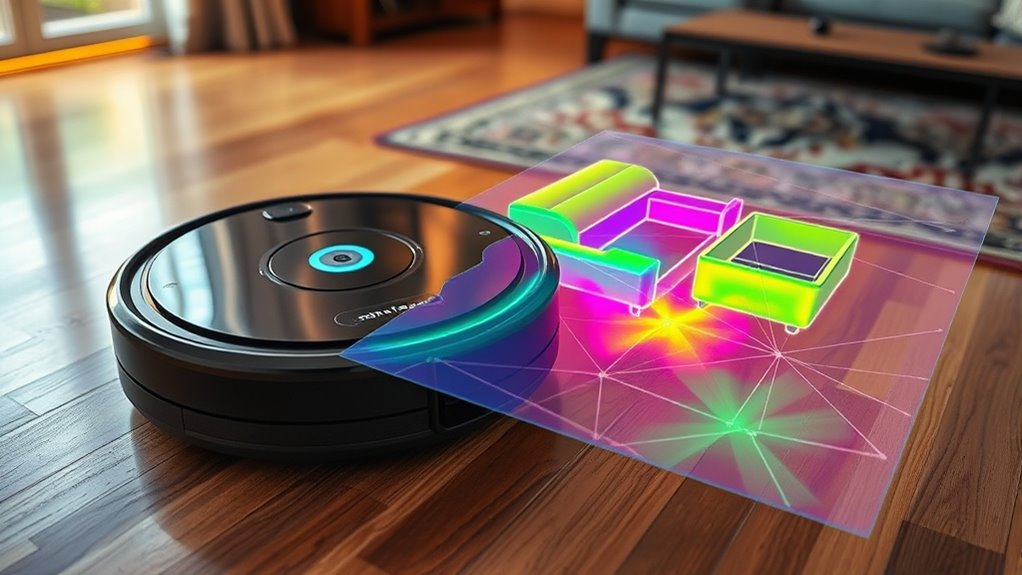
Choosing a robot vacuum carefully can substantially impact your privacy and data security. To make informed choices, consider these key factors:
- Review the manufacturer’s privacy policies, focusing on how they handle data collection and sharing.
- Opt for devices that implement data anonymization, ensuring your personal info isn’t linked to specific activities.
- Prioritize brands committed to ethical considerations, like transparent data practices and user control over data.
- Consider whether the device’s design incorporates security features that protect your data from unauthorized access.
Frequently Asked Questions
Can I Delete My Robot Vacuum’s Mapping Data After Use?
You can usually delete your robot vacuum’s mapping data through its privacy settings. Check the app or device interface for options related to data deletion or privacy controls. This process helps protect your privacy by removing stored maps after use. Always review your vacuum’s manual or manufacturer’s website for specific instructions, ensuring your data is securely deleted and your privacy is maintained.
Do All Robot Vacuums Share Data With Third-Party Advertisers?
The saying “don’t count your chickens before they hatch” rings true here—you can’t assume all robot vacuums share data with third-party advertisers. Some brands do, often without clear user consent, which raises privacy concerns. Always check your device’s privacy policy and settings. You have control over your data, so opt out of third-party sharing when possible to keep your home information safe from unwanted eyes.
How Often Do Robot Vacuums Update Their Privacy Policies?
You might wonder how often robot vacuums update their privacy policies. Typically, companies review and implement privacy policy updates annually or whenever new features are added. These updates clarify data retention periods and address privacy concerns. Staying informed helps you understand how your data is managed and whether your privacy is protected. Check the manufacturer’s website regularly for the latest privacy policy updates to guarantee your data remains secure.
Are There Legal Restrictions on Collecting Home Mapping Data?
Imagine over 60% of smart homes have robot vacuums collecting mapping data. You should know that privacy legislation varies by region, affecting what data can be collected and how it’s used. Data ownership rights mean you might have control over your home map, but laws differ. Always review your device’s privacy policies to understand legal restrictions and guarantee your data stays protected under local regulations.
Can I Limit Data Collection Without Impairing Device Functionality?
You can limit data collection without impairing your robot vacuum’s performance by adjusting privacy settings and enabling data minimization features. Check your device’s app for options to restrict mapping or data sharing. By customizing these settings, you control what information is collected, ensuring your privacy is protected while maintaining effective cleaning. Always review updates, as manufacturers often improve privacy options to help you stay in control.
Conclusion
While robot vacuums offer convenience, they also collect detailed data about your home. Think of them as silent observers, mapping your space with precision. Yet, you hold the power—your privacy depends on how you manage and control that data. Stay informed and proactive, balancing technology’s benefits with your right to privacy. After all, in a world of smart devices, knowledge is your best defense against unwanted intrusions.
